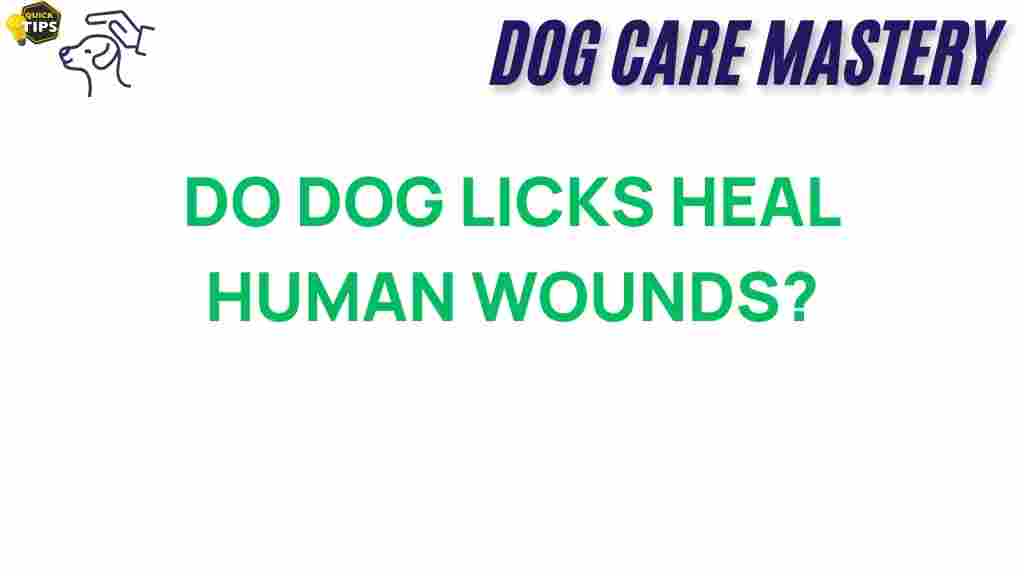Do Dog Licks Really Heal Human Wounds? Understanding Dog Licks
Dogs are often referred to as “man’s best friend,” and for good reason. Their loyalty, affection, and playful nature make them beloved companions. One quirky habit that many dogs have is licking their owners. Whether it’s a gentle lick on the face or an enthusiastic grooming session of a wound, many dog owners may wonder: do dog licks really heal human wounds? In this article, we will unpack the science behind dog licks, explore their potential benefits, and provide insights into whether these licks can be beneficial for healing.
The Science Behind Dog Licks
To understand whether dog licks can heal human wounds, we need to explore the composition of a dog’s saliva and how it interacts with human skin. Saliva is a complex fluid containing various components that can have different effects:
- Antimicrobial Properties: Dog saliva contains proteins and enzymes that can help combat bacteria. For example, a protein called lactoferrin can inhibit bacterial growth.
- Growth Factors: Certain growth factors in saliva have been shown to promote tissue regeneration, which may aid healing.
- Hydration: A lick can provide moisture to a wound, which is essential for the healing process.
However, this doesn’t necessarily mean that dog licks are a reliable or effective method for treating wounds. Let’s dive deeper into the pros and cons of dog licks.
Potential Benefits of Dog Licks
While dog licks are often viewed as a sign of affection, they may offer some benefits when it comes to healing. Here are a few potential advantages:
- Natural Antiseptic: The antimicrobial properties in dog saliva can help reduce the risk of infection in minor cuts and scrapes.
- Comfort and Bonding: The act of licking can provide comfort both to the dog and the owner, reinforcing the bond between them.
- Promoting Blood Flow: Licking can increase blood circulation to the area, which is important for healing.
The Risks of Dog Licks
Despite the potential benefits, there are significant risks associated with allowing your dog to lick your wounds:
- Transmission of Bacteria: While dog saliva contains some antimicrobial elements, it also harbors bacteria that can lead to infections. Dogs often lick various surfaces, including their own bodies, which can introduce harmful bacteria into human wounds.
- Parasites: If a dog has parasites, such as fleas or ticks, these can be transferred through saliva, potentially leading to more severe health issues.
- Allergic Reactions: Some people may develop allergic reactions to proteins found in dog saliva.
Understanding the Healing Process
When it comes to wound healing, the body goes through several stages:
- Hemostasis: The wound begins to stop bleeding.
- Inflammation: The body fights off potential infections.
- Proliferation: New tissue forms, and the wound begins to close.
- Maturation: The skin heals and strengthens over time.
While dog licks may contribute to certain aspects of healing, they should not replace proper wound care. It’s crucial to clean wounds thoroughly and use appropriate medical treatments when necessary.
Step-by-Step Process for Proper Wound Care
If you or someone you know has a wound, here’s a quick guide on how to care for it properly:
- Clean the Wound: Rinse the wound under cool running water to remove dirt and debris.
- Disinfect: Apply an antiseptic solution to eliminate bacteria.
- Cover: Use a sterile bandage or dressing to protect the wound from further injury and contamination.
- Monitor: Keep an eye on the wound for signs of infection, such as redness, swelling, or discharge.
- Seek Medical Attention: If the wound is deep or shows signs of infection, consult a healthcare professional.
Troubleshooting Tips for Wound Care
Here are some common issues you may encounter while caring for wounds and how to address them:
- Persistent Bleeding: If the wound continues to bleed, apply direct pressure and elevate the area. If bleeding does not stop within 10 minutes, seek medical help.
- Signs of Infection: If you notice increased redness, swelling, or pus, consult a healthcare professional. Infections may require antibiotics.
- Allergic Reactions: If you experience itching or swelling around the wound after applying ointments, discontinue use and consult a doctor.
What the Research Says
Several studies have looked into the effects of various animal saliva on human health. While some have indicated that dog saliva could have certain healing properties, the consensus remains that more research is necessary to draw definitive conclusions. For further reading on animal saliva and its effects, you can check out this study on animal saliva.
Conclusion: The Bottom Line on Dog Licks
In summary, while dog licks may seem comforting and could provide some minor benefits due to their antimicrobial properties, they are not a substitute for proper wound care. The risks associated with allowing dogs to lick wounds outweigh the potential benefits. Always prioritize cleaning and treating wounds with appropriate medical supplies and consult a healthcare professional when needed.
In the end, it’s crucial to remember that the bond between you and your dog is built on love and trust. Enjoy their affectionate licks, but when it comes to healing, stick to the science!
If you found this article helpful, consider checking out our other resources on pet care and health here.
This article is in the category Health and created by dogcaremastery Team
